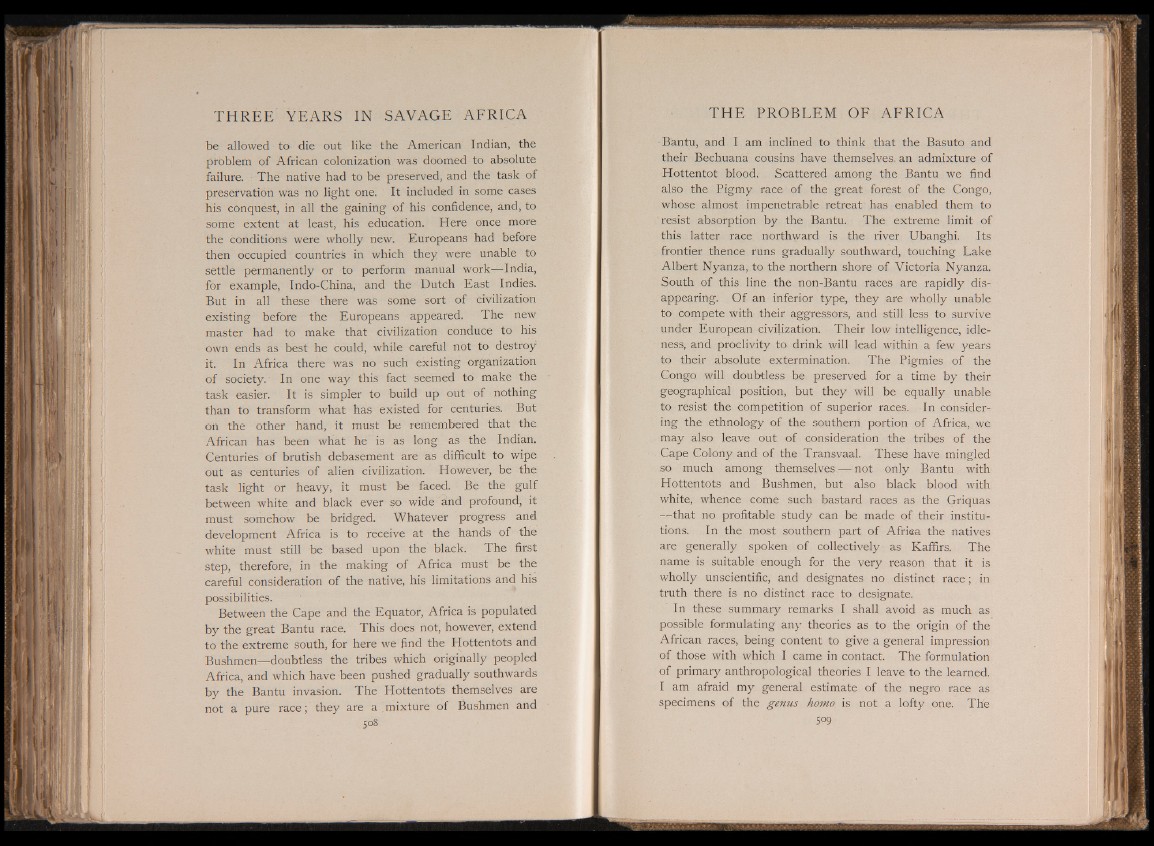
be allowed to die out like the American Indian, the
problem of African colonization was doomed to absolute
failure. The native had to be preserved, and the task of
preservation was no light one. It included in some cases
his conquest, in all the gaining of his confidence, and, to
some extent at least, his education. Here once more
the conditions were wholly new. Europeans had before
then occupied countries in which they were unable to
settle permanently or to perform manual work—India,
for example, Indo-China, and the Dutch East Indies.
But in all these there was some sort of civilization
existing before the Europeans appeared. The new
master had to make that civilization conduce to his
own ends as best he could, while careful not to destroy
it. In Africa there was no such existing organization
of society. In one way this fact seemed to make the
task easier. It is simpler to build up out of nothing
than to transform what has existed for centuries. But
on the other hand, it must be remembered that the
African has been what he is as long as the Indian.
Centuries of brutish debasement are as difficult to wipe
out as centuries of alien civilization. However, be the
task light or heavy, it must be faced. Be the gulf
between white and black ever so wide and profound, it
must somehow be bridged. Whatever progress and
development Africa is to receive at the hands of the
white must still be based upon the black. The first
step, therefore, in the making of Africa must be the
careful consideration of the native, his limitations and his
possibilities.
Between the Cape and the Equator, Africa is populated
by the great Bantu race. This does not, however, extend
to the extreme south, for here we find the Hottentots and
Bushmen—doubtless the tribes which originally peopled
Africa, and which have been pushed gradually southwards
by the Bantu invasion. The Hottentots themselves are
not a pure race; they are a mixture of Bushmen and
508
Bantu, and I am inclined to think that the Basuto and
their Bechuana cousins have themselves, an admixture of
Hottentot blood. Scattered among the Bantu we find
also the Pigmy race of the great forest of the Congo,
whose almost impenetrable retreat has enabled them to
resist absorption by the Bantu. The extreme limit of
this latter race northward is the river Ubanghi. Its
frontier thence runs gradually southward, touching Lake
Albert Nyanza, to the northern shore of Victoria Nyanza.
South of this line the non-Bantu races are rapidly disappearing.
Of an inferior type, they are wholly unable
to compete with their aggressors, and still less to survive
under European civilization. Their low intelligence, idleness,
and proclivity to drink will lead within a few years
to their absolute extermination. The Pigmies of the
Congo will doubtless be preserved for a time by their
geographical position, but they will be equally unable
to resist the competition of superior races. In considering
the ethnology of the southern portion of Africa, we
may also leave out of consideration the tribes of the
Cape Colony and of the Transvaal. These have mingled
so much among themselves — not only Bantu with
Hottentots and Bushmen, but also black blood with
white, whence come such bastard races as the Griquas
—that no profitable study can be made of their institutions.
In the most southern part of Afriaa the natives
are generally spoken of collectively as Kaffirs. The
name is suitable enough for the very reason that it is
wholly unscientific, and designates no distinct race; in
truth there is no distinct race to designate.
In these summary remarks I shall avoid as much as
possible formulating any theories as to the origin of the
African rac.es, being content to give a general impression
of those with which I came in contact. The formulation
of primary anthropological theories I leave to the learned.
I am afraid my general estimate of the negro race as
specimens of the genus homo is not a lofty one. The
509